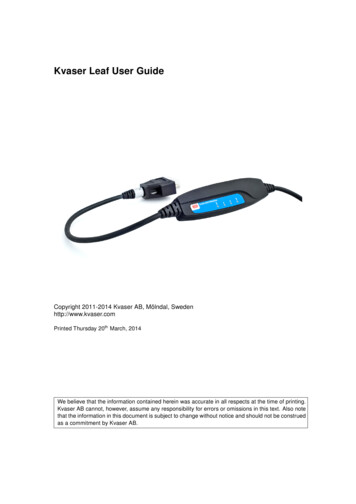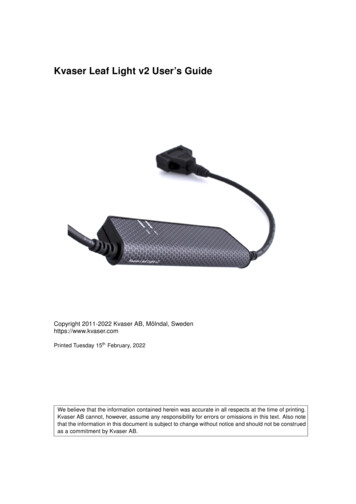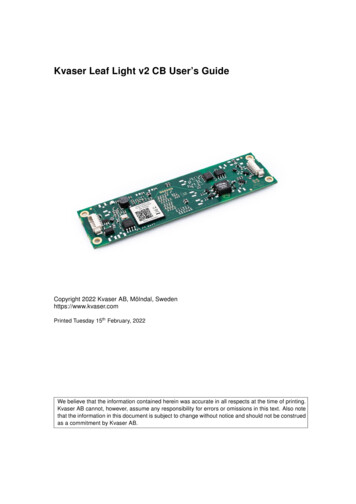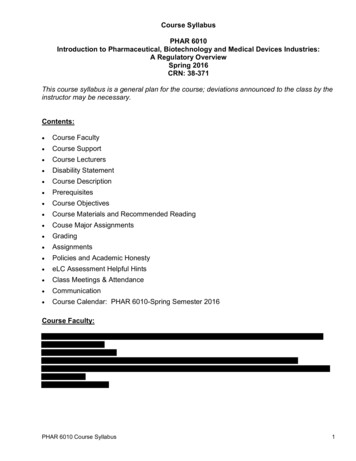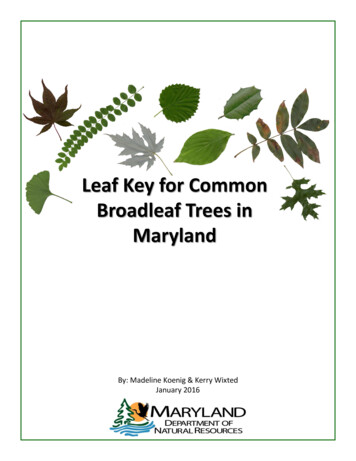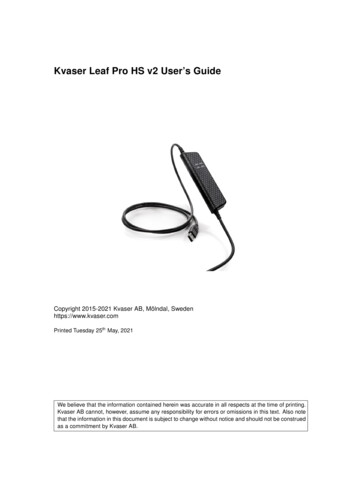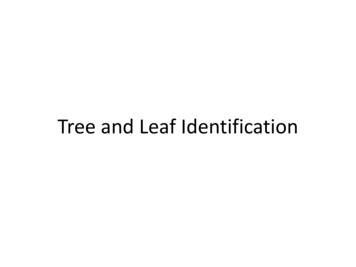
Transcription
Tree and Leaf Identification
Leaves Leaves are the best and often the easiest way toidentify a tree. Needles and scale of evergreens are also consideredleaves. Questions to consider when identifying leaves:– Are the leaves: simple or compound?margins smooth or margins rough?any sinuses or lobes?What is the size, shape, texture, and color variation of theleaves?
Plant Identification Bud - A compressed,undeveloped shoot. Budsmay be lateral or terminal. Node - point on the stemwhere leaf or bud is borne.The space between twonodes is an internode
ApexLeaf MarginLobeMidribVeinBasePetiole
Simple LeafPlant Identification– Petiole - the stalk of a leaf. Aleaf without a petiole issessile– Blade - the flat, expandedportion of the leaf
Plant Identification Leaf arrangement– Alternate - leavesarranged one per node
Plant Identification Leaf arrangement– Opposite - leavesarranged two per node
Plant Identification Leaf arrangement– Whorled - arranged twoor more per node
Leaf Arrangementalternateoppositewhorled
Simple Only one leaf blade Joined by its stalk to thewoody stem Examples: maple, oak,aspen, beechCompound Made up of severalleaflets Leaflets are joined to amidrib that is notwoody Examples: ash, walnut,sumac
Simple vs. Compound Leaves Simple - the blade is allin one piece, though itmay be lobed, toothed,etc.
Simple vs. Compound Leaves Compound - the bladeis divided all the way tothe midrib (rachis) intotwo or more pieces.
Compound Leaves
Simple vs. CompoundAxillary bud - the bud in the axil- the angle between the leafand stem.
Compound leaves– Once pinnately compound - leaflets arrangedalong one undivided main axis. (odd or evennumber of leaflets)
Compound leaves– Twice pinnatelycompound - main axis(rachis) with two or morebranches and the leafletsarranged along thebranches. The branchdivisions are primaryleaflets and the ultimatedivisions are secondaryleaflets. There can also bethrice-pinnatelycompound leaves,etc.
Compound leaves– Palmately compound -leaflets all arising fromone point at the base of the leaf.
Leaf TypeSimple vs. Compound
Simple or Compound?
What is the leaf type?
Leaf Characteristics Deciduous Evergreen
Which is which?DeciduousEvergreen
Characteristics of Evergreens Needle shaped leaves Seeds that developinside cones Evergreen – greenyear round Examples: pine,spruce, hemlock, fir
Evergreen leaves Needle like Scale like
Evergreen needles Clusters Singles
Deciduous Tree Characteristics Broad flat leaves Lose all leaves eachyear in the fall Angiosperm(flowering plants),broadleaf, hardwood Examples: oak,maple, beech, aspen,ash
Deciduous examplesRed oakBlack locustElmWhitebirchHoney locustRed maplebeechCrimson king
Leaf characteristics-deciduous Leaf arrangement: whorl,alternate, opposite Leaf type: simple orcompound Leaf edge: entire(smooth), lobed(projection), toothed(serrated) Leaf texture: hairy, waxy,rough, smooth, thick,thin, etc. Leaf shape: various
Leaf ObservationsDeciduousEvergreenLeaf arrangement:Leaves, needles orAlternate, opposite, whorl scalesLeaf type:Simple, compoundLeaf edge:Entire, lobed, toothedNeedle attachment:Single, clusters
Leaf EdgeLobed , smooth, toothed?
Leaf Venation, Lobing, Shape,& Margins Leaf venation– Pinnate - with a mainmidvein and secondaryveins arising from it atintervals
Leaf Venation, Lobing, Shape,& Margins Leaf venation– Palmate - with themain veins all arisingfrom one point at thebase of the leaf.
Leaf Venation, Lobing, Shape,& Margins Leaf venation– Parallel - with all the main veins parallel(usually also parallel to the sides of the leaf.)
Leaf Venation, Lobing, Shape,& Margins Leaf venation– Dichotomous - witheach vein branchingin two again andagain (e.g. Ginkgo)
Leaf Venation, Lobing, Shape,& Margins Leaf lobing– Pinnately lobed - with the lobesarising along the length of themid-line of the leaf.» Palmately lobed with the lobes allarising from onepoint at the base ofthe leaf.
Leaf Venation, Lobing, Shape,& Margins Leaf shapes– Ovate - egg-shaped with thelarger end at the bottom.» Elliptic - shaped likean ellipse, tapered atboth ends and withcurved sides.
Leaf Venation, Lobing, Shape,& Margins Leaf shapes– Oblong - tapered to both ends,but with the sides more or lessparallel.»Lanceolate - shapedlike the tip of a lance,broadest at the baseand tapered to a longpoint.
Leaf Venation, Lobing, Shape,& Margins Leaf shapes– Linear - very long and thin, withthe sides parallel»Cordate - heartshaped with the widepart at the bottom
Leaf Margins
Leaf Venation, Lobing, Shape,& Margins Leaf margins– Entire - smooth, with no teethor lobes
Leaf Venation, Lobing, Shape,& Margins Leaf margins– Serrate - with sharp,forward-pointingteeth
Leaf Venation, Lobing, Shape,& Margins Leaf margins– Doubly serrate - withteeth which havesmaller teeth on them
Leaf Venation, Lobing, Shape,& Margins Leaf margins– Serrulate - withvery tiny sharpteeth
Leaf Venation, Lobing, Shape,& Margins Leaf margins– Dentate - withteeth which pointoutwards
Leaf Venation, Lobing, Shape,& Margins Leaf margins– Crenate - with low,rounded scallop-liketeeth
Leaf Venation, Lobing, Shape,& Margins Leaf margins– Undulate - wavingup and down
Leaf Venation, Lobing, Shape,& Margins Leaf margins– Revolute - turned under
Leaf Venation, Lobing, Shape,& Margins Leaf margins– Lobed, parted, divided,cut, etc. - A number ofterms describe thevarious degrees oflobing.
Bark Color and Texture
Bark ColorTextureFurrowsAgeThorns
Twig clues Leaf scars aka budsare the places wherethe leaves used to beattached Size color and shapeof buds also useful toID trees
Bark and Twigs Lenticel - a "breathing pore"in the skin or bark of a stem.
Twigs & Buds
Flower clues ShapeColorTextureSize
Fruits & Seeds
Cones
Describe these leaves
Describe these leaves
Describe these leaves
Describe these leaves
Describe the leaves
Plant Identification Bud - A compressed, undeveloped shoot. Buds may be lateral or terminal. Node - point on the stem where leaf or bud is borne. The space between two nodes is an internode
